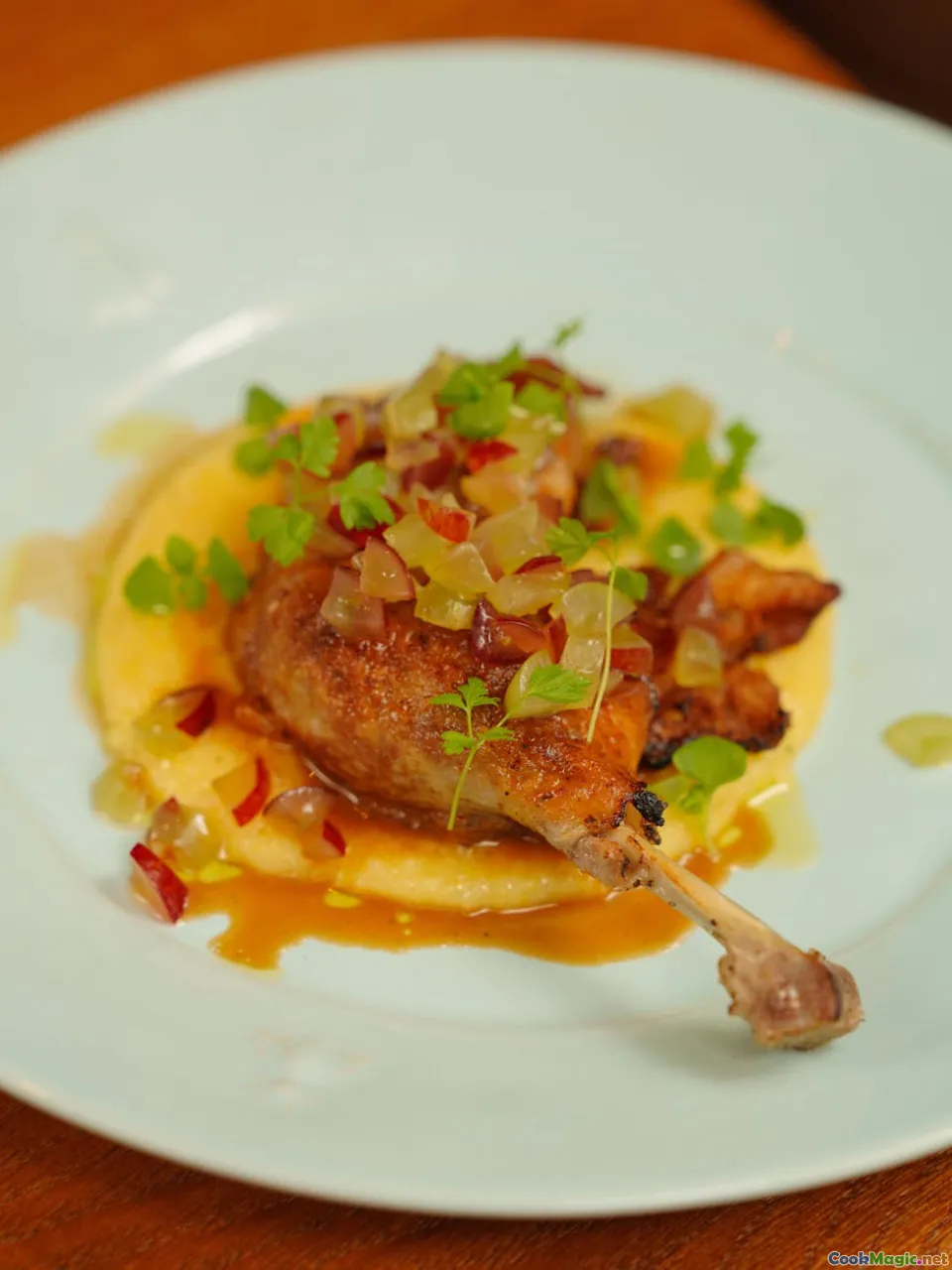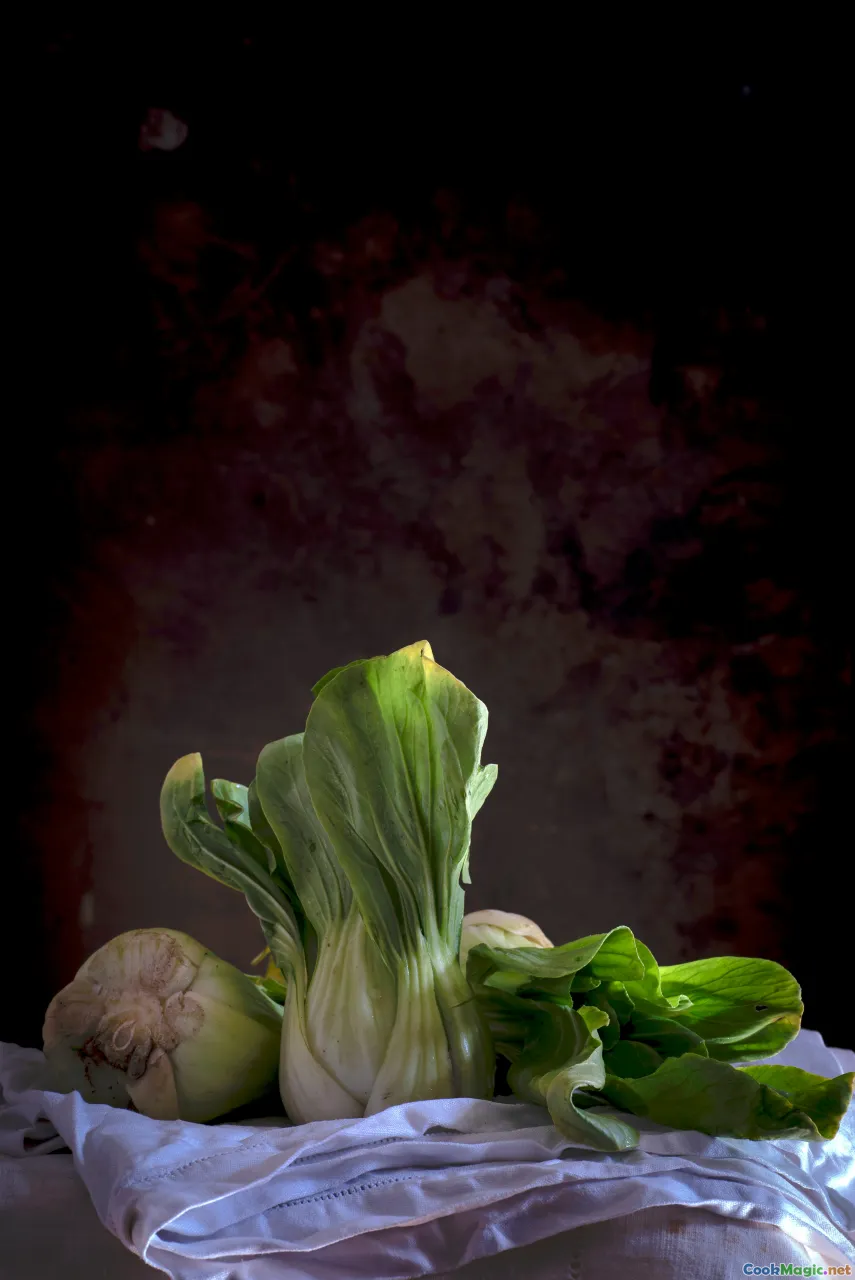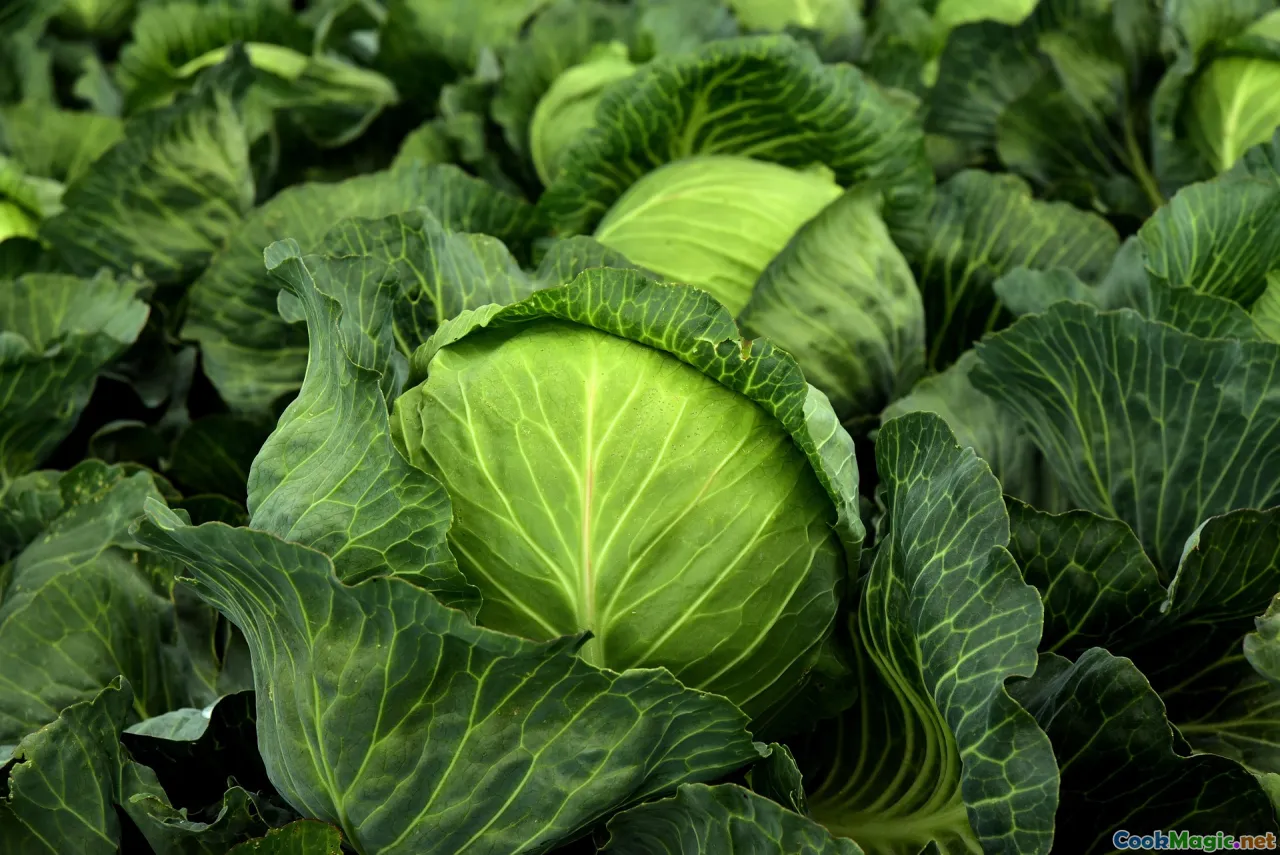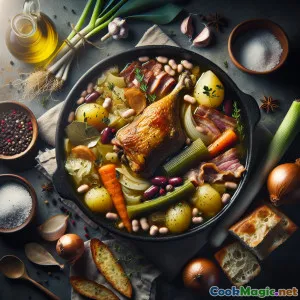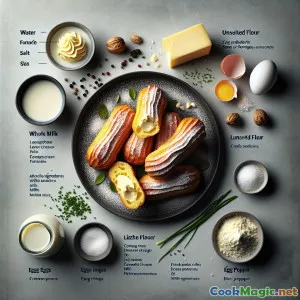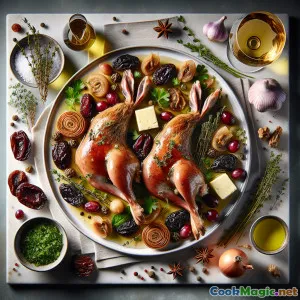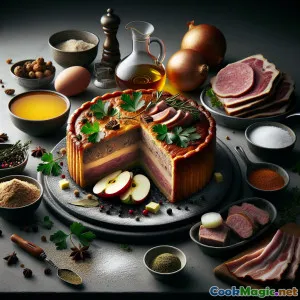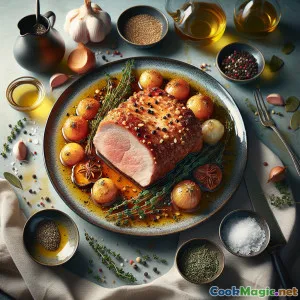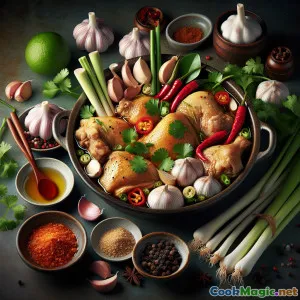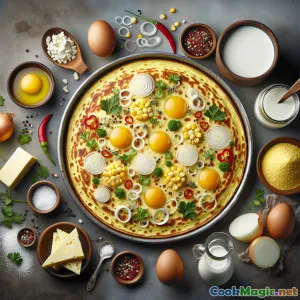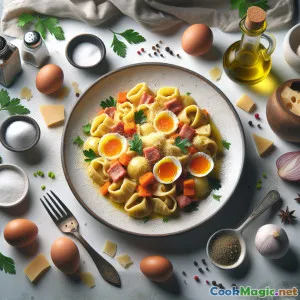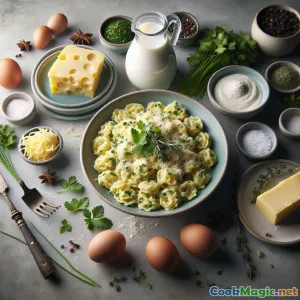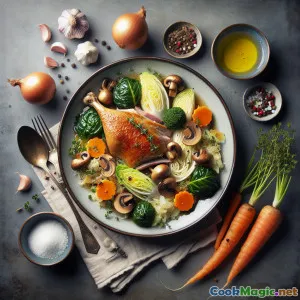
Col Recheada Gourmet con Pato Confitado
(Gourmet Stuffed Cabbage with Confit Duck)
(0 Reseñas)0
25
julio 26, 2025
Informar de un problema
Ingredientes
-
2 pieces Muslo de pato confitado
(Use pre-cooked confit duck legs for tenderness)
-
1 large Col china Savoy
(Outer leaves separated and blanched)
-
1 medium Cebolla
(Finamente picado)
-
1 medium Zanahoria
(Cortado en pequeños cubos)
-
2 pieces Ajo
(Picado)
-
100 grams Champiñones Cremini
(Chopped small)
-
100 grams Arroz blanco cocido
(Or substitute with quinoa for lighter texture)
-
1 large Huevo
(Binding agent)
-
1 teaspoon Tomillo Fresco
(Solo hojas)
-
2 tablespoons Grasa de pato cocida a fuego lento o aceite de oliva
(Reserve from confit or substitute oil)
-
3 tablespoons Migas de pan
(For sprinkle and texture)
-
1 teaspoon Sal
(Al gusto)
-
0.5 teaspoon Pimienta negra
(Recién abierto)
-
250 ml caldo de pollo
(For braising the parcels)
-
2 tablespoons Perejil fresco
(Finamente picado)
-
0.25 teaspoon Nuez moscada
(Freshly grated (optional))
(Use pre-cooked confit duck legs for tenderness)
(Outer leaves separated and blanched)
(Finamente picado)
(Cortado en pequeños cubos)
(Picado)
(Chopped small)
(Or substitute with quinoa for lighter texture)
(Binding agent)
(Solo hojas)
(Reserve from confit or substitute oil)
(For sprinkle and texture)
(Al gusto)
(Recién abierto)
(For braising the parcels)
(Finamente picado)
(Freshly grated (optional))
Nutrición
- Porciones: 4
- Tamaño de porción: 1 porción (250g)
- Calories: 550 kcal
- Carbohydrates: 32 g
- Protein: 28 g
- Fat: 34 g
- Fiber: 7 g
- Sugar: 6 g
- Sodium: 780 mg
- Cholesterol: 120 mg
- Calcium: 120 mg
- Iron: 3.4 mg
Instrucciones
-
1 - Blanch Cabbage Leaves:
Bring a large pot of salted water to boil. Detach 12–14 cabbage leaves, blanch for 3 minutes until pliable, then drain and pat dry on kitchen towels.
-
2 - Prepare Duck Filling:
Remove skin and bone from confit legs; shred the duck meat. In a large skillet, heat 1 tablespoon duck fat or oil, and sauté onion, carrot and garlic until soft. Add chopped mushrooms, cook until water evaporates, then stir in cooked rice, shredded duck meat, thyme and parsley. Season generously with salt, pepper, and nutmeg if using. Remove from heat and let cool slightly.
-
3 - Bind Mixture with Egg:
Crack the egg in a small bowl, beat lightly, and mix well into the filling to help bind.
-
4 - Wrap the Parcels:
Lay 3 blanched cabbage leaves slightly overlapping. Spoon filling along bottom edge. Fold sides then roll up to enclose, forming a tight parcel. Repeat to use all filling.
-
5 - Arrange Parcels in Baker:
Place assembled cabbage parcels seam-side down in a buttered baking dish. Sprinkle with breadcrumbs and drizzle with the remaining duck fat or olive oil.
-
6 - Braise in Stock and Bake:
Preheat oven to 180°C/350°F. Pour chicken stock around cabbage parcels, cover with foil and bake for 40 minutes. Remove foil, continue baking 20 minutes to crisp breadcrumbs and reduce liquid.
-
7 - Plate and Garnish:
Gently transfer parcels to plates. Spoon over pan juices. Garnish with extra parsley. Serve hot.
Bring a large pot of salted water to boil. Detach 12–14 cabbage leaves, blanch for 3 minutes until pliable, then drain and pat dry on kitchen towels.
Remove skin and bone from confit legs; shred the duck meat. In a large skillet, heat 1 tablespoon duck fat or oil, and sauté onion, carrot and garlic until soft. Add chopped mushrooms, cook until water evaporates, then stir in cooked rice, shredded duck meat, thyme and parsley. Season generously with salt, pepper, and nutmeg if using. Remove from heat and let cool slightly.
Crack the egg in a small bowl, beat lightly, and mix well into the filling to help bind.
Lay 3 blanched cabbage leaves slightly overlapping. Spoon filling along bottom edge. Fold sides then roll up to enclose, forming a tight parcel. Repeat to use all filling.
Place assembled cabbage parcels seam-side down in a buttered baking dish. Sprinkle with breadcrumbs and drizzle with the remaining duck fat or olive oil.
Preheat oven to 180°C/350°F. Pour chicken stock around cabbage parcels, cover with foil and bake for 40 minutes. Remove foil, continue baking 20 minutes to crisp breadcrumbs and reduce liquid.
Gently transfer parcels to plates. Spoon over pan juices. Garnish with extra parsley. Serve hot.
Más información sobre: Col Recheada Gourmet con Pato Confitado
Chou Farci au Canard Confit: An Ode to French Cuisine
Few dishes evoke the rustic charm and sophisticated depth of French home cooking like chou farci, or stuffed cabbage. Bringing a unique twist to tradition, Chou Farci au Canard Confit unites luscious confit duck—a hallmark of Gascon markets—with tender Savoy cabbage, aromatic herbs, and comforting vegetables. This one-pan masterpiece beckons both to the family tables of Southwest France and the creative spirits of modern gourmet kitchens.
The Essence of Chou Farci
Stuffed vegetables are celebrated throughout Europe, with each culture filling leaves, roots, or fruit with ingredients both luxurious and humble. Yet France’s chou farci has always been more than just a comfort dish: it’s a vehicle for showcasing thrift, patience, and that subtle sense of elevating everyday items. Adding confit duck—a labor of love adored since the times of Henry IV—catapults the dish into lavish territory, transforming common cabbage into a festive centerpiece.
Unique Aspects and Personal Thoughts
Making Chou Farci au Canard Confit is a lesson in contrasts: silken, Savoy cabbage leaves swaddle rich shreds of duck and flavorful vegetables. The nuts of umami from mushrooms, sweetness from carrots, and gentle perfuming of thyme and parsley bring harmony. Finished in the oven with crisped breadcrumbs and golden duck fat, the parcels are simultaneously hearty and elegant.
While this recipe requires several steps, it is remarkably forgiving—a must for advanced home cooks or anyone hosting a convivial Sunday lunch. The key is starting with pre-cooked duck confit, which can be sourced easily at delicatessens or specialty grocers. Leftover vegetables work well in the stuffing, so don’t hesitate to fold in celery, parsnip, or even lentils. For a gluten-free version, swap breadcrumbs with ground almonds or omit them.
History in a Leaf
Confit is an ancient preservation technique relying on gently cooking meats in fat. Once transformative for rural economies, it provided sustenance through cooler months. Meanwhile, chou farci runs through French culinary history as proof of their skill in flavor layering and practicality. Uniting the two, especially with the wildness of duck, was most certainly born of abundance—a dish on the cusp of feast and frugality.
Presentation is key: carved into cross-sections, cabbage parcels reveal their intricate, honorable filling. Garnish liberally with fresh herbs, and don’t neglect to spoon over the pan’s golden, aromatic juices. These are the secret gourmandises that distinguish a homemade meal from the rest.
Cultural Significance and Serving Tips
In Gascony, such dishes might anchor wedding tables or mark midwinter celebrations; but in modern kitchens, they shine wherever generosity and conviviality are desired. The advanced assembly and braising are deeply satisfying for seasoned cooks looking to master classical technique or impress at a holiday fête.
Tips & Tricks:
- Use duck fat for supreme crispness but olive oil for a lighter interpretation.
- Selecting tender, bright-green cabbage ensures a supple wrapper.
- Make ahead: assemble parcels up to a day in advance, then finish with stock and baking.
- For a rustic version, add lardons or smoked bacon to the filling.
Serve this with a glass of robust red Bordeaux and peppery arugula salad.
Why You'll Love It
With every forkful, expect contrasts: succulence of duck, sweet earthy vegetables, gentle bitterness of wilted cabbage, and luxurious, golden roast aromas. It is a dish that honors French culinary wisdom and invites innovation—every bite lauds both tradition and creativity.

